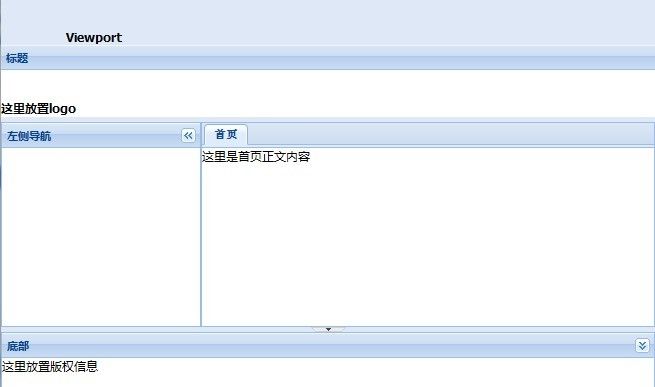ExtJs4 笔记(9) Ext.Panel 面板控件、 Ext.window.Window 窗口控件、 Ext.container.Viewport 布局控件
本篇讲解三个容器类控件。
一、面板控件 Ext.Panel
一个面板控件包括几个部分,有标题栏、工具栏、正文、按钮区。标题栏位于最上面,工具栏可以在四个位置放置,围绕中间部分正文,按钮区位于最小方。下面介绍几个基本配置项:
1.title:设置面板标题文本。
2.tbar,lbar,rbar,bbar:分别设置上、左、右、下四个部位的工具栏。
3.html,items:前者用来设置正文部分的html,后者设置正文部分的ext控件。
4.buttons:设置按钮区的按钮。
下面看看面板生成代码:
[html]|
1
2
3
|
<
h1
>Panel</
h1
>
<
div
id
=
"div1"
class
=
"content"
>
</
div
>
|
[Js]
|
1
2
3
4
5
6
7
8
9
10
11
12
13
14
15
16
17
18
19
20
21
22
23
24
25
26
27
28
29
30
31
32
33
34
|
Ext.onReady(
function
() {
var
p = Ext.create(
'Ext.Panel'
, {
title:
'面板标题'
,
collapsible:
true
,
renderTo:
'div1'
,
width: 400,
height: 300,
autoScroll:
false
,
bodyBorder:
true
,
buttonAlign:
'right'
,
buttons: [{
text:
"按钮1"
,
handler:
function
() {
Ext.Msg.alert(
"提示"
,
"第一个事件"
);
},
id:
"bt1"
}, {
text:
"按钮2"
,
id:
"bt2"
}
],
floating:
true
,
footerCfg: { tag:
'span'
, id:
'span1'
, html:
'面板底部'
},
items: [{
xtype:
"button"
,
text:
"按钮"
}],
tbar: Ext.create(
'Ext.toolbar.Toolbar'
, { items: [
"工具栏"
] }),
html:
"<b>正文</b>"
});
p.setPosition(40, 50);
});
|
效果如下:
二、窗口控件 Ext.window.Window
窗口控件与面板控件基本类似,只不过他看起来像一个窗口,具备最大化,最小化,打开关闭、拖动等窗口操作,下面看看窗口生成代码:
下面看看面板生成代码:
[html]|
1
2
3
4
5
|
<
h1
>窗口</
h1
>
<
div
class
=
"content"
style
=
"height:300px"
>
<
button
id
=
"button1"
>打开窗口</
button
>
<
div
id
=
"win1"
></
div
>
</
div
>
|
[Js]
|
1
2
3
4
5
6
7
8
9
10
11
12
13
14
15
16
17
18
19
20
21
22
23
24
25
26
27
28
29
30
31
32
33
34
35
36
37
38
39
40
41
42
43
44
45
46
47
48
49
50
51
52
53
54
55
56
|
Ext.onReady(
function
() {
var
window1 = Ext.create(
'Ext.window.Window'
, {
applyTo:
'win1'
,
layout:
'table'
,
//内部元素布局方式{absolute accordion anchor border card column fit form table}
width: 500,
height: 200,
closeAction:
'hide'
,
//窗口关闭的方式:hide/close
plain:
true
,
title:
"窗口标题"
,
maximizable:
true
,
//是否可以最大化
minimizable:
true
,
//是否可以最小化
closable:
false
,
//是否可以关闭
modal:
true
,
//是否为模态窗口
resizable:
false
,
//是否可以改变窗口大小
items: [{
text:
'按钮'
,
xtype:
"button"
}, {
width: 214,
minValue: 0,
maxValue: 100,
value: 50,
xtype:
"slider"
}, {
xtype:
"button"
,
text:
'一个菜单'
,
width:
"60px"
,
height:
"15px"
,
menu: {
items: [
new
Ext.ColorPalette({
listeners: {
select:
function
(cp, color) {
Ext.Msg.alert(
'颜色选择'
,
'你选择了'
+ color +
'。'
);
}
}
}),
'-'
,
{ text:
'菜单项1'
}, { text:
'菜单项2'
}, { text:
'菜单项3'
}
]
}
}],
buttons: [{
text:
'确定'
,
disabled:
true
}, {
text:
'取消'
,
handler:
function
() {
window1.hide();
}
}]
});
Ext.fly(
"button1"
).on(
"click"
,
function
() {
window1.show(Ext.get(
"button1"
));
});
});
|
效果如下:
三、布局控件 Ext.container.Viewport
布局控件一般用于整个页面的排版布局,它按四个方向分为四块区域,和中间正文部分,四个区域都可以自动隐藏,其实这个控件的核心功能就是用到了“border”方式的布局,下面看看生成代码:
[Js]|
1
2
3
4
5
6
7
8
9
10
11
12
13
14
15
16
17
18
19
20
21
22
23
24
25
26
27
28
29
30
31
32
33
34
35
36
37
38
|
Ext.onReady(
function
() {
Ext.create(
'Ext.container.Viewport'
, {
layout:
'border'
,
items: [{
region:
'north'
,
html:
'<h1>这里放置logo</h1>'
,
xtype:
"panel"
,
title:
"标题"
,
autoHeight:
true
,
border:
false
,
margins:
'0 0 5 0'
}, {
region:
'west'
,
collapsible:
true
,
title:
'左侧导航'
,
xtype:
'panel'
,
width: 200,
autoScroll:
true
}, {
region:
'center'
,
xtype:
'tabpanel'
,
activeItem: 0,
items: {
title:
'首页'
,
html:
'这里是首页正文内容'
}
}, {
region:
'south'
,
title:
'底部'
,
collapsible:
true
,
//允许折叠
html:
'这里放置版权信息'
,
split:
true
,
height: 100,
minHeight: 100
}]
});
});
|
效果如下:
作者:李盼(Lipan)
出处: [Lipan] ( http://www.cnblogs.com/lipan/)
版权声明:本文的版权归作者与博客园共有。转载时须注明本文的详细链接,否则作者将保留追究其法律责任。
出处: [Lipan] ( http://www.cnblogs.com/lipan/)
版权声明:本文的版权归作者与博客园共有。转载时须注明本文的详细链接,否则作者将保留追究其法律责任。


